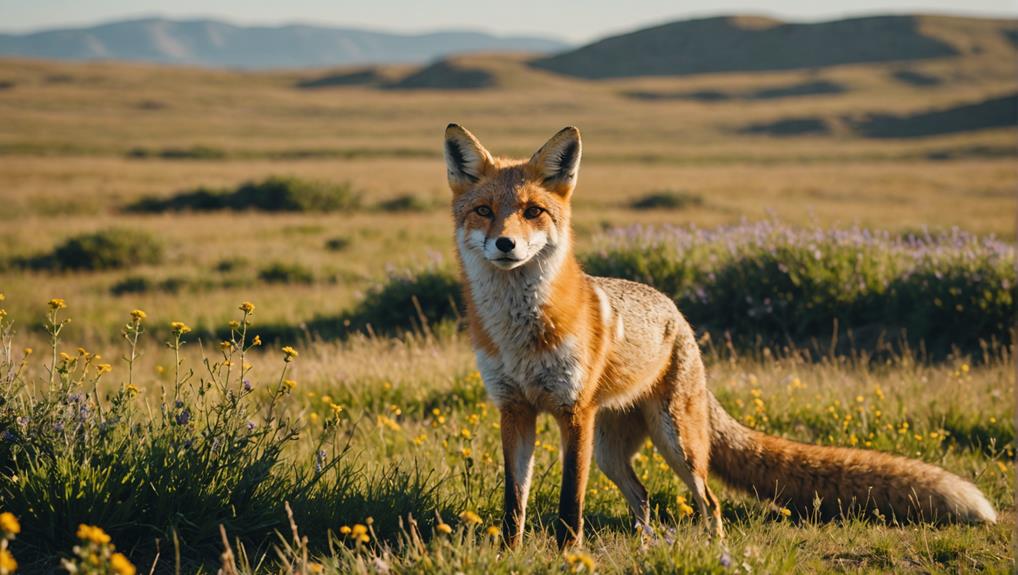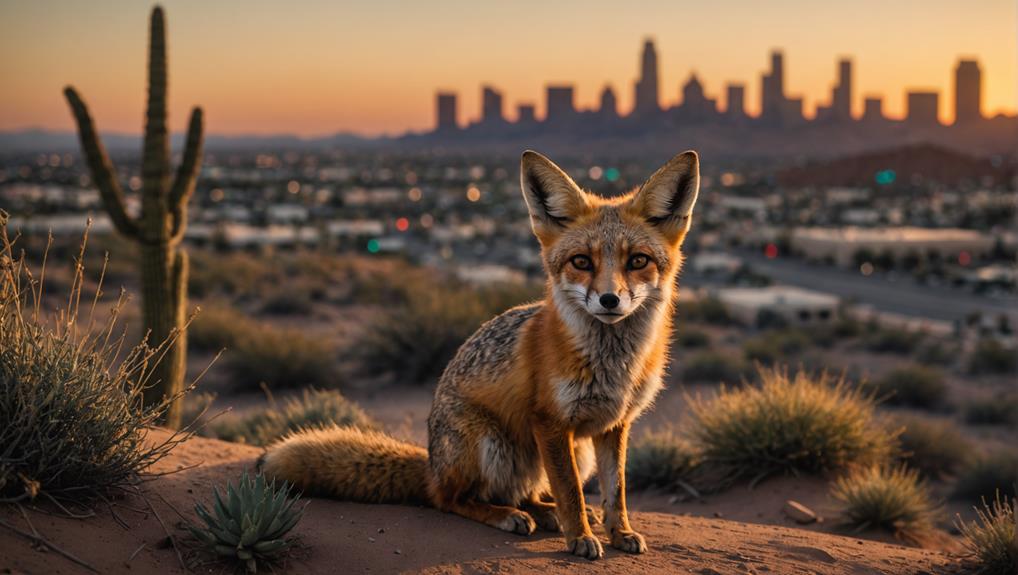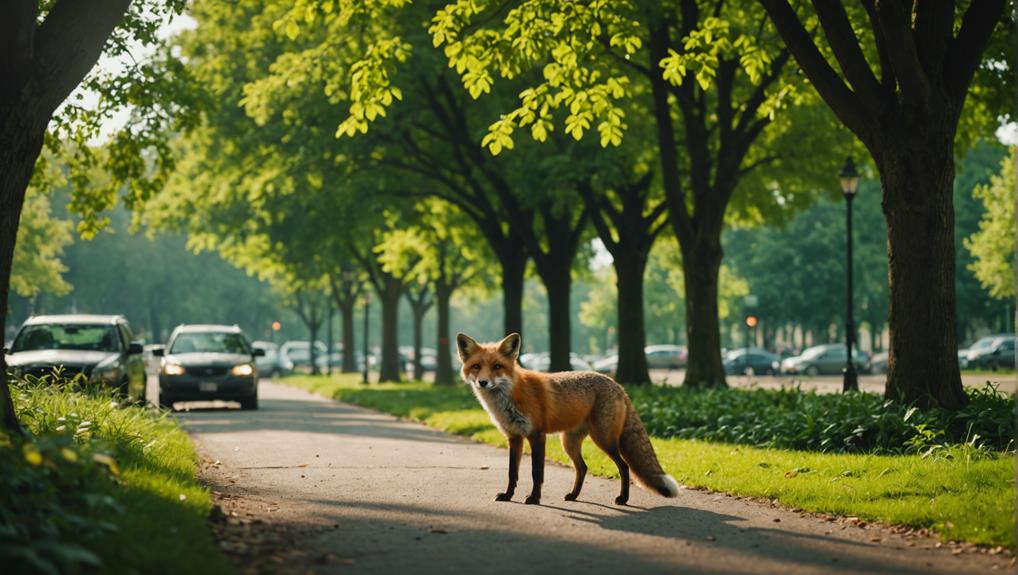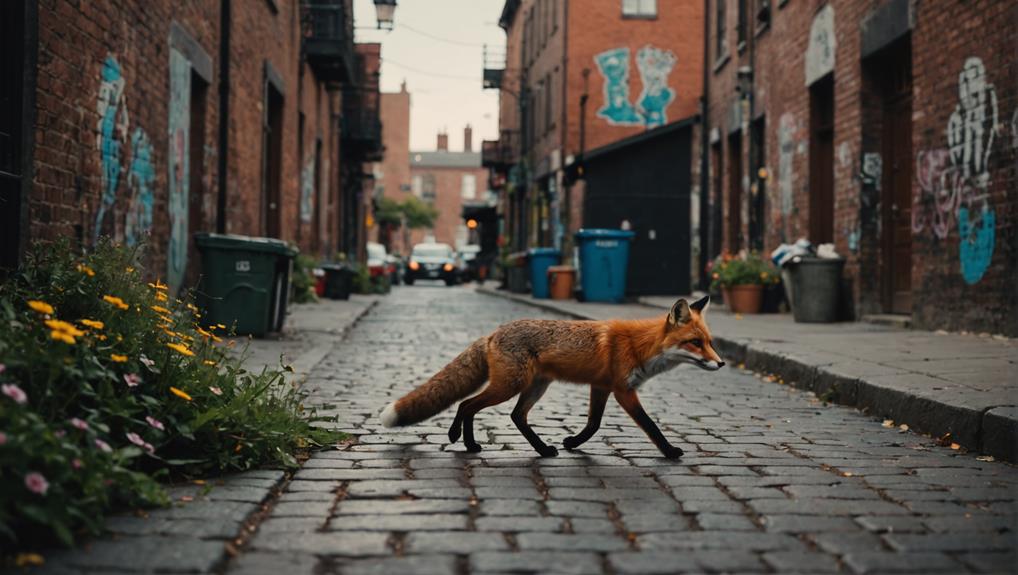You'll be amazed at the seven urban fox species that thrive in our cities! The Red Fox, with its cunning ways, makes homes in gardens and parks, while the swift Swift Fox prefers shortgrass prairies. Then there's the Arctic Fox, adapted to the cold, showcasing snazzy fur changes, and the Kit Fox that enjoys the desert nightlife. Don't forget the Fennec Fox, with its comically large ears, perfect for urban survival! These clever critters show impressive adaptability and form unique social structures. Curious about their habits and how they coexist with us? Stick around, and you'll uncover even more fascinating facts!
Contents
Urban Fox Overview
Urban foxes, particularly the red fox (*Vulpes vulpes*), have become a common sight in cities across the UK, with an estimated 150,000 individuals recorded in 2017.
These clever creatures have adapted remarkably well to urban areas, making gardens, parks, and other green spaces their homes. You might find them rummaging through your trash or sneaking a snack in your backyard. Their diet is quite fascinating, too—about 50% meat and 50% household refuse! Talk about being resourceful.
Since the 1930s, urban red foxes have thrived in southern UK cities, showcasing their incredible adaptability to human habitats. They've learned to navigate our world, and it's a sight to behold.
Their populations are influenced by food availability and territory, which helps keep their numbers in check, even if we saw a decline of 42% in 2018.
Red Fox: The City Dweller
When you think of city life, you might picture bustling streets and crowded parks, but have you ever spotted a red fox roaming around?
These clever little critters have mastered urban living, adapting their diets and social behaviors to thrive alongside us humans.
From raiding your trash cans to playing hide-and-seek in your garden, red foxes are a fascinating part of our urban ecosystem, and it's time to explore how they make city life work for them!
Urban Adaptation Strategies
Over the years, red foxes have transformed into adept city dwellers, seamlessly integrating into urban environments. You might be surprised to learn that their populations in the UK skyrocketed from 33,000 in 1995 to a staggering 150,000 by 2017! This remarkable adaptation showcases how these clever creatures have made urban habitats their own.
Red foxes are masters of finding cozy dens, often tucked away under sheds or nestled in bushes, making them perfect spots for raising their cubs. When it comes to feeding, they're not picky eaters. In fact, about half of their diet comes from household refuse! They've become quite the opportunists, thriving on whatever resources the city provides.
To avoid too much human interaction, urban red foxes tend to be nocturnal. But don't be fooled; they can still make appearances during the day. Their strong adaptability allows them to coexist with other wildlife and navigate even the busiest neighborhoods.
It's amazing how these furry urbanites can flourish in places where one mightn't expect wildlife at all. So, next time you spot a red fox, remember—it's not just surviving, it's thriving!
Dietary Habits in Cities
Red foxes have adapted their diets to thrive in city environments, striking a balance between natural hunting and scavenging. You might be surprised to learn that in urban landscapes, their meals consist of about 50% meat and 50% household refuse. This clever adaptability allows red foxes to make the most of what's available around them, especially when their usual prey—small mammals like voles and rabbits—aren't as plentiful.
Here are some of the food sources these urban dwellers enjoy:
- Discarded fast food
- Small pets (so keep an eye on your little furry friends!)
- Wild birds
- Insects
- Seasonal fruits
Their omnivorous nature is truly remarkable. With strong stomachs, red foxes can even handle rotting food scraps, making them resilient in densely populated areas.
When hunting, they rely on their keen sight and smell to locate prey, showcasing their impressive skills even amid the hustle and bustle of city life.
Social Behavior and Structure
Urban red foxes exhibit fascinating social behaviors that reflect their adaptability and intelligence. You might find it surprising that these clever creatures often form small social groups, usually consisting of two to six adults. They forage independently but stay connected through playful vocalizations and friendly physical interactions. Isn't that charming?
Breeding pairs are quite strong, sticking together throughout the breeding season and working as a team to raise their adorable kits. In bustling urban settings, these foxes often become nocturnal, cleverly avoiding human interactions while embracing their city life. They've even mastered the art of raising cubs in parks, gardens, and yes, even stadiums!
Within these social groups, you'll notice a bit of hierarchy at play. Dominant pairs lead the pack, guiding foraging strategies and territory management like seasoned pros. They know how to make the most of their surroundings, proving once again that urban red foxes aren't just survivors—they're thriving!
The Swift Fox

Let's take a closer look at the swift fox, a little dynamo of the Great Plains.
These small, agile creatures have some pretty specific habitat preferences, often snuggling into abandoned dens for a cozy home.
You'll find that their diet is as flexible as their name suggests, featuring everything from small mammals to the occasional fruit—talk about a diverse menu!
Habitat Preferences
Swift foxes (*Vulpes velox*) showcase remarkable adaptability in their habitat preferences, favoring shortgrass prairies and mixed grasslands across North America.
These clever critters thrive in places where they can easily hunt and find shelter. They often make use of burrows created by fellow small mammals, like prairie dogs, and love areas with open fields for their hunting adventures.
Here are some key points about their habitat preferences:
- They prefer southern Canada and states like Montana, Wyoming, and Colorado.
- Swift foxes flourish at elevations below 4,500 feet.
- They adapt well to fragmented landscapes, which helps them survive in urban areas.
- Their population densities have declined due to habitat loss from agriculture and development.
- They can even utilize agricultural lands when natural grasslands are hard to find.
While red foxes may get more attention, swift foxes are incredible survivors.
With their unique adaptations, they can find a home in mixed landscapes, proving that even in the face of change, nature always finds a way.
Diet and Behavior
During twilight and nighttime, the swift fox (*Vulpes velox*) engages in a dynamic feeding routine that reflects its adaptability and opportunistic nature.
These clever little foxes are true opportunistic feeders, meaning they're not picky eaters! Their diet mainly includes small mammals like rodents and rabbits, but they're also known to chow down on insects, fruits, and even some plants when the season is right.
In urban areas, their behavior shifts slightly, but they still thrive. You'll find them hunting during dawn and dusk to dodge predators and avoid human encounters.
Swift foxes are social creatures, with females often claiming their own territories. They'll even reuse burrows dug by other animals—talk about resourcefulness!
These foxes prefer habitats that offer a mix of grasslands and prairies, which are perfect for their hunting and denning needs.
Watching swift foxes in action is like a little nature show right in your backyard! You might even find yourself rooting for these adorable furballs as they dart through the grass, showcasing their remarkable hunting skills and charming behavior.
Arctic Fox Adaptations
Arctic foxes have evolved remarkable adaptations that enable them to thrive in some of the harshest climates on Earth. Their thick fur coat isn't just for show; it changes color with the seasons! This clever camouflage helps them blend into the snowy landscape in winter and the tundra vegetation during summer. You can imagine how tricky it must be for small mammals like lemmings to spot them!
Here are some of the coolest adaptations Arctic foxes have:
- Thick, insulating fur coat for warmth
- Short ears and compact bodies to conserve heat
- Ability to reduce blood flow to extremities in extreme cold
- Specialized diet, mainly preying on small mammals
- Adaptable social behavior, forming monogamous pairs
These furry little creatures also demonstrate adaptable social behavior. They often form monogamous pairs, working together to raise their adorable kits.
With a litter size of 5 to 8, these foxes create cozy underground dens to nurture their young. So next time you think of Arctic foxes, picture their resilience and teamwork; it's a beautiful reminder of how nature finds a way, even in the coldest places!
Kit Fox in Urban Deserts

While Arctic foxes showcase their resilience in frigid environments, kit foxes reveal their own set of remarkable adaptations in urban deserts. These small, desert-dwelling creatures, weighing between 4 to 6.5 pounds, have made a name for themselves in urban areas across the southwestern United States and northern Mexico. Their large ears aren't just for show; they help them hear the tiniest movements of small mammals like rodents scurrying through the sand.
When night falls, the kit fox springs into action. With agility that would impress even the most seasoned acrobat, they navigate urban landscapes, hunting and scavenging under the cover of darkness.
You might be surprised to learn that their food sources extend beyond the usual desert fare. In cities, they can find tasty treats in trash cans or even from unsuspecting domestic pets.
These clever foxes avoid the heat of the day and the hustle of human activity, making urban deserts their playground. By understanding the life of the kit fox, we can appreciate their adaptability and the unique role they play in our shared environment.
Who knew a small fox could thrive so well amidst the concrete and chaos?
Fennec Fox: Urban Survivor
The fennec fox, often regarded as the ultimate desert survivor, is a small yet remarkably adaptable creature that thrives in urban landscapes. You might be surprised to learn that these little foxes, with their big ears and fluffy tails, can also make themselves at home in bustling cities. Their ability to adapt is impressive, allowing them to scavenge for food and find shelter among human habitats.
Here are some fascinating facts about the fennec fox:
- They form close-knit family groups, enhancing their survival.
- They've an omnivorous diet, eating insects, small rodents, and plants.
- Their large ears help regulate their body temperature and improve hearing.
- Fennec foxes can often be spotted rummaging through urban trash for tasty scraps.
- They thrive in both their natural desert habitat and in urban environments.
These clever little animals demonstrate incredible adaptation skills, proving that survival isn't just about where you live, but how you live.
Whether in the Sahara or your local neighborhood, the fennec fox shows us that life can be full of surprises, even in the most unexpected places!
Conservation and Coexistence

In urban environments, conserving the delicate balance between human activities and wildlife is crucial for fostering coexistence with urban foxes. These clever creatures have adapted remarkably, and with a bit of effort, we can all help them thrive.
By preserving green spaces in our neighborhoods, we support not only urban foxes but also the biodiversity that enriches our lives.
Educating ourselves and others about food waste is vital. Secure your trash cans and compost responsibly to reduce attractants. After all, who wants a fox rummaging through their leftovers? It's all about finding ways to coexist peacefully.
Community efforts, like those from local councils and organizations like the RSPCA, promote awareness about urban foxes. They remind us to report injured foxes instead of trying to handle them ourselves.
Moreover, embracing non-lethal management strategies can help maintain a healthy urban fox population. These strategies recognize the benefits urban foxes bring, like keeping rodent numbers in check.
Final Thoughts
In the end, urban foxes are fascinating creatures that adapt to city life in ways that surprise us. From the clever red fox to the resourceful fennec fox, these animals teach us about resilience and coexistence. We can appreciate their quirky habits while also helping them thrive in our neighborhoods. So, next time you spot a fox on your evening stroll, remember: they're not just wild animals; they're part of our urban family, adding a little wild charm to our lives!














